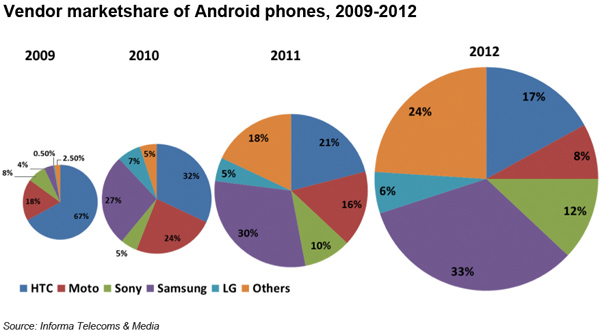Friday, August 31. 2012
How Does the Curiosity Rover Nuclear Battery Work?
Via About Robots
-----

The nuclear battery is the black 'tail'
Photo courtesy of NASA
First, I'll tell you its real name: NASA calls it the Multi-Mission Radioisotope Thermoelectric Generator, or MMRTG. And the principle is quite simple: the radioactive plutonium generates heat by splitting naturally into more stable atoms. The heat is used to 'cook' a thermocouple that generates electricity to the whole system.
Okay, so just like you, my next question was: what is a thermocouple? When you make 2 different metals touch each other, it creates a tension (voltage) that is dependant on the temperature. It is very reliable to calculate the tension from the temperature if you use the right metals. Now, if you want to make a battery, you just need to have 2 junctions at 2 different temperatures. You can get more info from Wikipedia's page on thermocouple. That's it: the Plutonium generates very regular heat over several years, the heat hits up the warm part of the thermocouple, and the thermocouple generates electricity to the system.
The whole system is safe enough and small enough that even if the rocket explodes at launch, the Plutonium would most likely not be released, and it's release wouldn't even be a problem.
Has it been used before?
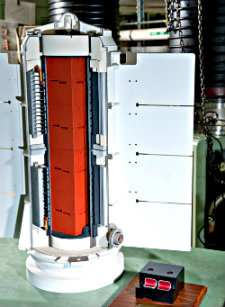 |
Yes it has! It has been used since the Apollo mission. The first time I heard about the Curiosity Rover nuclear battery, I was thinking this must be top notch technology. What a surprised I had when I saw it has been used for more that 40 years already. It's never too late to learn how it works anyway.
Let's quote NASA: "The Apollo missions to the moon, the Viking missions to Mars, and the Pioneer, Voyager, Ulysses, Galileo, Cassini and New Horizons missions to the outer solar system all used radioisotope thermoelectric generators."
Still, the Curiosity Rover nuclear battery is a new generation battery that is used for the first time on this Mars rover. As NASA says, it is more flexible and can be used on a wide variety of missions since they have better control over the tension delivered by the new system.
In particular, only the new generation can deliver 14 years of energy within a 45kg, 60X60X60cm box. Yes, it is not much different from the boiler in your house, but so much more powerful.
Let's compare to Solar Panels
Why didn't they send the Mars Science Laboratory with solar panels like the 2 previous generations of Mars rovers?
In short, NASA wanted to make this mission better and faster. The 2 main drawbacks of solar panels is that they don't work during the night, and they don't work during the Martian winter. One consequence is that the Mars Exploration Rovers couldn't work for more that half of the time.
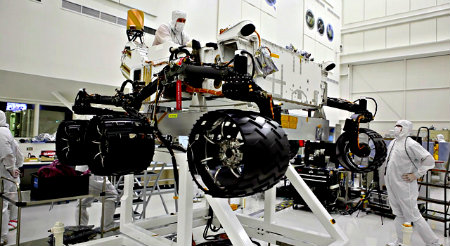 |
The Curiosity Rover Nuclear Battery will supply the system with constant power, allowing it to work as much as needed, all year long for as long as 14 years. Imagine the difference when the rover is traveling from one point to another if it doesn't have to stop every night.
Another thing is that the new rover is much bigger and holds more experimental tools, and can go a little faster. All in all, the power supply from the nuclear battery is nearly 3 times more than the solar panels (in day time).
All these are clear good reasons for the Mars Science Laboratory to go to Mars with some Plutonium in its backpack.
Thursday, August 30. 2012
The Apple Tax, Part II
Via Monday Note
-----
Once upon a time, Steve Ballmer blasted Apple for asking its customers to pay $500 for an Apple logo. This was the “Apple Tax“, the price difference between the solid, professional workmanship of a laptop running on Windows, and Apple’s needlessly elegant MacBooks.
Following last week’s verdict against Samsung, the kommentariat have raised the specter of an egregious new Apple Tax, one that Apple will levy on other smartphone makers who will have no choice but to pass the burden on to you. The idea is this: Samsung’s loss means it will now have to compete against Apple with its dominant hand — a lower price tag — tied behind its back. This will allow Apple to exact higher prices for its iPhones (and iPads) and thus inflict even more pain and suffering on consumers.
There seems to be a moral aspect, here, as if Apple should be held to a higher standard. Last year, Apple and Nokia settled an IP “misunderstanding” that also resulted in a “Tax”…but it was Nokia that played the T-Man role: Apple paid Nokia more than $600M plus an estimated $11.50 per iPhone sold. Where were the handwringers who now accuse Apple of abusing the patent system when the Nokia settlement took place? Where was the outrage against the “evil”, if hapless, Finnish company? (Amusingly, observers speculate that Nokia has made more money from these IP arrangements than from selling its own Lumia smartphones.)
Even where the moral tone is muted, the significance of the verdict (which you can read in full here) is over-dramatized. For instance, see this August 24th Wall Street Journal story sensationally titled After Verdict, Prepare for the ‘Apple Tax’:
After its stunning victory against rival device-maker Samsung Electronics Co., experts say consumers should expect smartphones, tablets and other mobile devices that license various Apple Inc., design and software innovations to be more expensive to produce.
“There may be a big Apple tax,” said IDC analyst Al Hilwa. “Phones will be more expensive.”
The reason is that rival device makers will likely have to pay to license the various Apple technologies the company sought to protect in court. The jury found that Samsung infringed as many as seven Apple patents, awarding $1.05 billion in damages.
The $1B sum awarded to Apple sounds impressive, but to the giants involved, it doesn’t really change much. Samsung’s annual marketing budget is about $2.75B (it covers washer-dryers and TVs, but it’s mostly smartphones), and, of course, Apple is sitting on a $100B+ cash hoard.
Then there’s the horror over the open-ended nature of the decision: Apple can continue to seek injunctions against products that infringe on their patents. From the NYT article:
…the decision could essentially force [Samsung] and other smartphone makers to redesign their products to be less Apple-like, or risk further legal defeats.
Certainly, injunctions could pose a real threat. They could remove competitors, make Apple more dominant, give it more pricing power to the consumer’s detriment…but none of this is a certainty. Last week’s verdict and any follow-up injunctions are sure to be appealed and appealed again until all avenues are exhausted. The Apple Tax won’t be enforced for several years, if ever.
And even if the “Tax” is assessed, will it have a deleterious impact on device manufacturers and consumers? Last year, about half of all Android handset makers— including ZTE, HTC, Sharp — were handed a Microsoft Tax bill ($27 per phone in ZTE’s case), one that isn’t impeded by an obstacle course of appeals. Count Samsung in this group: The Korean giant reportedly agreed to pay Microsoft“between $10 and $15 – for each Android smartphone or tablet computer it sells.” Sell 100M devices and the tax bill owed to Ballmer and Co. exceeds $1B. Despite this onerous surcharge, Android devices thrive, and Samsung has quickly jumped to the lead in the Android handset race (from Informa, Telecoms & Media):
Amusingly, the Samsung verdict prompted this gloating tweet from Microsoft exec Bill Cox:
Windows Phone is looking gooooood right now.
(Or, as AllThingsD interpreted it: Microsoft to Samsung. Mind if I Revel in Your Misfortune for a Moment?)
The subtext is clear: Android handset makers should worry about threats to the platform and seek safe harbor with the “Apple-safe” Windows Phone 8. This will be a “goooood” thing all around: If more handset makers offer Windows Phone devices, there will be more choices, fewer opportunities for Apple to get “unfairly high” prices for its iDevices. The detrimental effects, to consumers, of the “Apple Tax” might not be so bad, after all.
The Samsung trial recalls the interesting peace agreement that Apple and Microsoft forged in 1997, when Microsoft “invested” $150M in Apple as a fig-leaf for an IP settlement (see the end of the Quora article). The interesting part of the accord is the provision in which the companies agree that they won’t “clone” each other’s products. If Microsoft could arrange a cross-license agreement with Apple that includes an anti-cloning provision and eventually come up with its own original work (everyone agrees that Microsoft’s Modern UI is elegant, interesting, not just a knock-off), how come Samsung didn’t reach a similar arrangement and produce its own distinctive look and feel?
Microsoft and Apple saw that an armed peace was a better solution than constant IP conflicts. Can Samsung and Apple decide to do something similar and feed engineers rather than platoons of high-priced lawyers (the real winners in these battles)?
It’s a nice thought but I doubt it’ll happen. Gates and Jobs had known one another for a long time; there was animosity, but also familiarity. There is no such comfort between Apple and Samsung execs. There is, instead, a wide cultural divide.
Wednesday, August 29. 2012
Swiss sheep to warn shepherds of wolf attacks by SMS
Via Phys Org
-----

"It's the first time that such a system has been tried outdoors," said biologist Jean-Marc Landry, who took part in testing on a Swiss meadow this week. In the trial, reported by the country's news agency ATS, around 10 sheep were each equipped with a heart monitor before being targeted by a pair of Wolfdogs -- both of which were muzzled. During the experiment, the change in the flock's heartbeat was found to be significant enough to imagine a system whereby the sheep could be fitted with a collar that releases a repellent to drive the wolf away, while also sending an SMS to the shepherd. The device is aimed at owners of small flocks who lack the funds to keep a sheepdog, Landry said, adding that it could also be used in tourist areas where guard dogs are not popular. A prototype collar is expected in the autumn and testing is planned in Switzerland and France in 2013. Other countries including Norway are said to be interested. The issue of wolves is a divisive one in Switzerland where the animals appear to be back after a 100-year absence. On July 27 a wolf killed two sheep in St Gall, the first such attack in the eastern canton. (c) 2012 AFP
Read more at: http://phys.org/news/2012-08-swiss-sheep-shepherds-wolf-sms.html#jCp
Read more at: http://phys.org/news/2012-08-swiss-sheep-shepherds-wolf-sms.html#jCp
Read more at: http://phys.org/news/2012-08-swiss-sheep-shepherds-wolf-sms.html#jCp
Read more at: http://phys.org/news/2012-08-swiss-sheep-shepherds-wolf-sms.html#jCp
Tuesday, August 28. 2012
The Facebook camera that can recognise you every time you walk into a shop
Via Daily Mail
-----
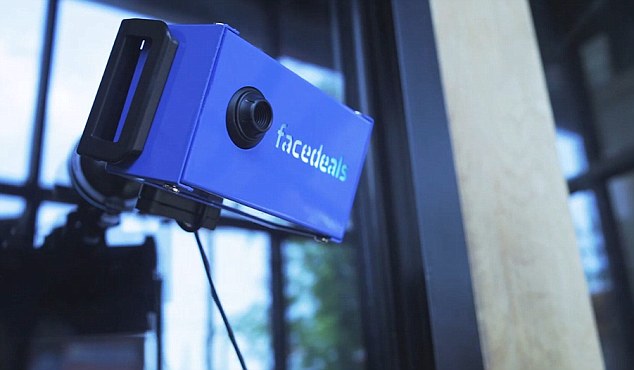
Facedeals - a new camera that can recognise shoppers from their Facebook pictures as they enter a shop, and then offer them discounts
A promotional video created to promote the concept shows drinkers entering a bar, and then being offerend cheap drinks as they are recognised.
'Facebook check-ins are a powerful mechanism for businesses to deliver discounts to loyal customers, yet few businesses—and fewer customers—have realized it,' said Nashville-based advertising agency Redpepper.
They are already trialling the scheme in firms close to their office.
'A search for businesses with active deals in our area turned up a measly six offers.
'The
odds we’ll ever be at one of those six spots are low (a strip club and
photography studio among them), and the incentives for a check-in are
not nearly enticing enough for us to take the time.
'So we set out to evolve the check-in and sweeten the deal, making both irresistible.
'We call it Facedeals.'

The Facedeal camera can identify faces when people walk in by comparing Facebook pictures of people who have signed up to the service
Facebook recently hit the headlines when it bought face.com, an Israeli firm that pioneered the use of face recognition technology online.
The social networking giant uses the software to recognise people in uploaded pictures, allowing it to accurately spot friends.
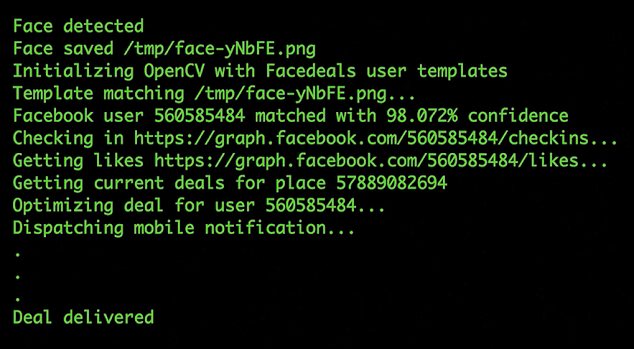
The software uses a complex algorithm to find the correct person from their Facebook pictures
The Facebook camera requires people to have authorised the Facedeals app through their Facebook account.
This verifies your most recent photo tags and maps the biometric data of your face.
The system then learns what a user looks like as more pictures are approved.
This data is then used to identify you in the real world.
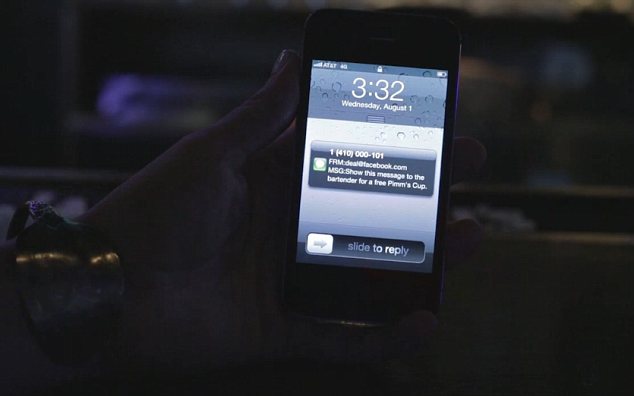
In a demonstration video, the firm behind the camera showed it being used to offer free drinks to customers if they signed up to the system.
Quicksearch
Popular Entries
- The great Ars Android interface shootout (130673)
- Norton cyber crime study offers striking revenue loss statistics (100893)
- MeCam $49 flying camera concept follows you around, streams video to your phone (99679)
- Norton cyber crime study offers striking revenue loss statistics (57122)
- The PC inside your phone: A guide to the system-on-a-chip (56965)
Categories
Show tagged entries
Syndicate This Blog
Calendar
|
|
August '12 |
|
||||
| Mon | Tue | Wed | Thu | Fri | Sat | Sun |
| 1 | 2 | 3 | 4 | 5 | ||
| 6 | 7 | 8 | 9 | 10 | 11 | 12 |
| 13 | 14 | 15 | 16 | 17 | 18 | 19 |
| 20 | 21 | 22 | 23 | 24 | 25 | 26 |
| 27 | 28 | 29 | 30 | 31 | ||
